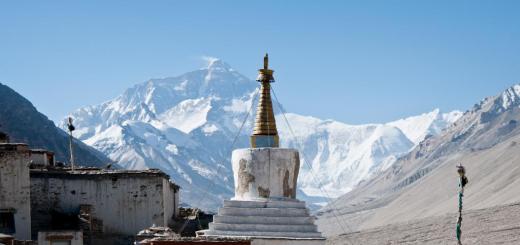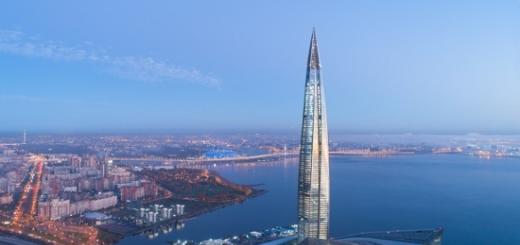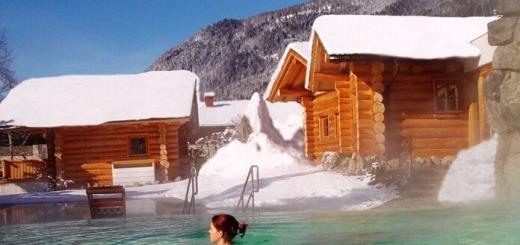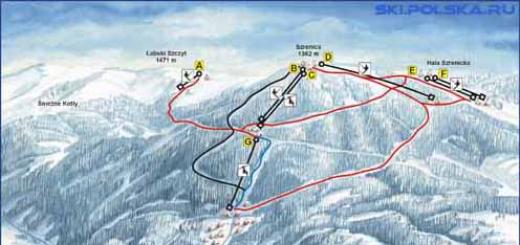Everest is the European name for the mountain, which has long been called by the locals, Tibetans, Chomolungma. This name translates as "Divine Mother of Life". The Nepalese, who observed the mountain from the south, called it the "Mother of the Gods", which sounds like "Sagarmatha". The name "Everest" was given to the mountain by the name of the English surveyor George Everest.
Until the middle of the 19th century, there was no exact data on the height of the mountain, so its title of the highest peak was unofficial. In 1852, an Indian mathematician made a series of calculations and determined that Everest is the highest mountain on Earth.
Everest was formed by the collision of two plates - Hindustan and Eurasia. The Indian plate went under the crust in Tibet, and the mantle was lifted up, resulting in a large mountain range, which still continues to grow due to the slow movement of tectonic plates.
Everest location
The Himalayan mountains cover a vast territory in the Tibetan and Indo-Ghana plains, separating the desert and mountain regions of Central Asia and the tropical regions of South Asia. The mountains stretch for almost 3 thousand kilometers in length, and are 350 kilometers wide. The area of the Himalayas is about 650 thousand kilometers, and the average height of the peaks is about 6 thousand meters above sea level.
Everest is the highest Himalayan mountain. The mountain in the form of a trihedral pyramid has two peaks: the northern one with a height of 8848 meters is located on the territory of China, or rather, the Tibet Autonomous Region, and the southern one with a height of 8760 runs right along the border of China with Nepal.
On all sides, the peak is surrounded by mountains and smaller ridges: in the south, Chomolungma connects with the eight-thousander Lhotse, between them lies the South Col Pass; from the north is the North Col, which leads to Mount Changze. On the east side of Everest is a steep impenetrable wall called Kangashung.
Not far from the mountain are the peaks of Nuptse, Makalu, Chomo Lonzo. The mountain is also surrounded by glaciers located at an altitude of five thousand meters: Ronbuk, East Rongbuk. From the north of Everest stretches the gorge of the Rong River.
Partially, the mountain is located on the territory of the Nepalese Sagarmatha National Park, which consists of gorges, mountain ranges and rugged areas in the Upper Himalayas.
The nearest major cities to Everest are -
Greetings my inquisitive readers, or as they say in China "Nihao". You are probably wondering why I suddenly spoke in Chinese? Everything is simple! Today I would like to tell you about the most beautiful and at the same time dangerous Mount Everest.
Everest, or as the locals call it Chomolungma, is considered the highest point on earth above sea level. There are so many legends and stories around this amazing peak that you yourself begin to think “maybe I should risk conquering Everest?”
I’ll tell dreamers and just adventurers right away that even among trained professional climbers, not everyone dares to climb Chomolungma. It is only in photographs and videos that climbers smile with happiness, standing among the never-melting ice. In reality, this is an extremely life-threatening occupation. Only one attempt to climb Everest out of ten is successful. In other cases, many simply turn back when a few tens of meters remain to the top.
Everest height above sea level
Everything from the fact that the last meters are the most difficult and dangerous, and few dare to risk their lives once again. The height of Everest above sea level, according to officially accepted data, is 8848 meters, but disputes are still ongoing. China, for example, believes that the height of the highest mountain in the world is four meters less. They measured without taking into account the ice cap.
But the Americans established with the help of navigation instruments that Everest is two meters higher, the Italians, in general, consider the mountain to be eleven meters higher than the official figure. In general, while there are disputes, the official height remains the same. But every year, the mountain grows by several centimeters, due to the constant movement of lithospheric plates.
Chomolungma: some historical facts
It is known from history that Everest used to be the bottom of an ancient ocean. But due to the beginning of the movement of the titanic plates, when the Indian lithospheric plate collided with the Eurasian one, a large mountainous Himalayan range rose. And Everest was at the head of it. The plates keep shifting, so in the near future the mountain will only grow. Of course, if it had not been trampled down by hundreds of tourists trying to climb to the top, it would have grown faster. Kidding.
There are many fans in the world who dream of conquering this mysterious mountain at least once in their lives. But often their dreams are not destined to come true, and the main reason for this is. After all, a full-fledged expedition needs something around $ 100,000. And this is not counting the fact that health should be just perfect. At a minimum, you should be able to run 10 kilometers of cross-country skiing. Least.
The best time to climb Everest
Everest is part of a large chain of mountain ranges of the Himalayas. Everest itself is surrounded by younger brothers, so you can see the mountain in full glory only by climbing to the neighboring peaks.
In winter, the temperature at the peak of Everest can drop to -60 0 C. And in the summer, in the warmest month, July does not rise above -19 0 C. But spring is considered the most suitable season for climbing. In summer, there are frequent monsoon rains at the top. And in the fall it is already dangerous, due to the possible avalanches.
In which country is the highest mountain Everest located?
There were many disputes here, because Nepal and China were at enmity for a very long time, and when relative peace was established (although it looks more like an occupation than peace), it was decided to draw a border, just in the middle of the peak of Everest. Now officially the mountain is located on the territory of two states, and is equally considered the property of both countries. The southern part of Everest is located in Nepal and the northern part is in Tibet, an autonomous region of China.
Until the middle of the nineteenth century, Knchenjunga was considered the highest mountain, but thanks to the Welsh mathematician George Everest, who proved that Everest is higher, the scientific world recognized this fact. The mountain was named after him.
Temperature at the top of Everest
In general, on Everest, let's say, it's not hot. The temperature there never rises above 0 degrees. The coldest month is January. This month, the average level of the thermometer is -36 degrees Celsius, and can drop to -60C. The warmest month is July. You can comfortably “warm up” at minus 19 degrees Celsius (average value).
Where is the most beautiful view of Everest?
To see how beautiful Everest is, you need to overcome several obstacles.
First is to climb to the top of Kalapattar.
It is from her that a view of the glacier opens, as if Everest rises above the whole world.
Second- choose a good time to shoot, because due to poor visibility, you can spend the whole day and not take a single photo. The weather in the mountains is constantly changing, and every minute here is worth its weight in gold.
Everest conquerors: the most famous records of the Earth
The first to climb the peak of Everest was the scientist Edmund Hillary, with him was his assistant Sherpa Tenzing Norgay, a local resident and guide.
The youngest conqueror of the peak is 13-year-old American Jordan Romnro. Of course, the Japanese also did not stand aside, and it was the Japanese who became the oldest conqueror - 80-year-old Yuchiro Miura
The list goes on, a variety of records were set on the roof of our world. They used it to snowboard, send messages and photos to social networks, and much more.
The one who put on a great freestyle snowboarding show was Marco Siffredi. Not to be confused with Rocko.
Look at the photos of both Mount Everest itself and its surroundings, which the Internet is full of, and you will understand why the mountain attracts travelers from all over the world so much. By the way, Yandex did something like a virtual tour of Everest.
In its significance, Everest can be compared, perhaps with, which is considered the deepest in the world.
Although Everest is considered the roof of the world, other mountains of considerable height are not far behind the mountain - Lhotse, which is its neighbor. And the famous volcano in Russia and Europe - which is also one of the seven largest peaks in the world.
What does above sea level mean?
Interesting question, right? Scientists several centuries ago considered that it would be more correct to measure the height of the land, starting from the sea line. It is convenient and there are no unnecessary questions. After all, everything above the sea line is land and animals and people can live on it, and what is below is the seabed. Of course, it is also from the earth, only people cannot live there.
So, any measurement of the height of mountains and various ranges is measured in this way, from sea level. If the reporting point were different, then Everest would no longer be the largest peak in the world. And its place would be taken by the famous Hawaiian volcano Mauna Kea, 4200 m high, going down another 6000 meters. Count for yourself.
The unusual story of conquering the summit of Everest
During the civil war, many centuries ago, when a brother went against his brother, one young guy fell in love with a beautiful girl, but they were not destined to be together because their families were enemies. The girl liked the guy too. After all, he was brave and strong, and most importantly, he did not retreat from his love. Despite prohibitions and enmity, he fought for his beloved.
But, unfortunately, the couple in love found out about their relationship and decided to forcibly marry the girl and take her to her husband in another village. The girl managed to convey a message to her lover about this event. And the guy in love decided to steal his beloved and run away from the enmity and war that was imposed on them.
On the day when the wedding ceremony was to take place, the bride was transported in a special wagon to the place where the groom was waiting. But on the way, a guy in love caught up with the wagon and extorted escort, took his girlfriend, and they galloped as far as possible. But here failure awaited them, since the horse could not carry two for a long time, so it quickly ran out of steam. And at this time, a chase was sent for the fugitives.
And when the lovers were already catching up, the girl began to pray for their salvation. God, having heard such a sincere request to save his beloved, decided to help. Suddenly, a strong whirlwind rose under the couple, and carried them to the foot of Mount Chomolungma.
And since then, the highlanders who live in the most sacred place believe that they were chosen by the gods. Therefore, traditions are still sacredly honored.
How much does it cost to conquer Everest?
Anyone who has read about Everest knows that traveling is not cheap. And with average estimates, it will cost $ 100,000, or even more. Most of this amount will go to the fee that every tourist who wants to conquer the highest mountain pays. It is $35,000 and is revised every year.
Of course, many of you will be outraged, "robbery" and so on. But even with such numbers, there are enough applicants, and every year their number is growing. But every climber conquering Everest leaves behind mountains of garbage, and who will clean it up. After all, you can’t deliver transport to the mountain, because the air is very rarefied. And not every person dares to get up and clean up dirty tourists.
Of course, most of the equipment becomes unusable or simply unnecessary, for example, used oxygen tanks, and it is very difficult to carry the extra load to the top. After all, with every kilometer it becomes more difficult to go, and weight matters when you climb the peak.
For each person, the rise can last in different ways, from a month to 4. It all depends on the state of your health and the experience of climbing other mountain peaks.
Well, if you still dare to go on an expedition, then learn in advance everything about the mountain itself and the payment for additional services of guides and guides, this is not counting the porters and the climbing equipment itself. Make an estimate of the ascent, and go!
Good luck in conquering Everest and remember the wisdom of the highlanders living there for many generations: “Everest has a soul, it honors the attitude and character of the person who decided to conquer it. And if you do it only out of vanity, the mountain will never submit to you!”.
I hope my article was useful to you and you will share it with your friends. Write your questions and subscribe to. See you soon!
In contact with
A man lives in Nepal who conquered the “top of the world” 21 times, and amazing spiders live on the very top, which was once the seabed. The mountain is still growing, has not even two, but four official names and, by the way, is not the highest in the world.
(Total 10 photos)
Post sponsor: A massage chair is nothing more than your own massage parlor!
Source: restbee.ru

1. Himalayan spiders
Even high in the mountains, where there is barely enough oxygen to breathe, we cannot hide from the spiders. Euophrys omnisuperstes, better known as the Himalayan jumping spider, hides in the nooks and crannies of Everest, making it one of the highest living creatures on Earth. Climbers found them at an altitude of 6700 meters. These spiders are able to feed on almost everything that can fly so high. With the exception of some species of birds, they are the only living creatures that permanently live at such an altitude. True, in 1924, during a British expedition to Everest, a previously unknown species of grasshoppers was found here - now they are on display in the British Museum of Natural History.

2. Record climbing Everest - 21 times
Appa Tenzing, also known as Appa Sherpa, was able to conquer the top of the world 21 times. Its first ascent took place in May 1990, after three earlier unsuccessful attempts. Apparently, having learned all the secrets of climbing, Appa continued to conquer Everest every year - from 1990 to 2011. He repeatedly stressed that the effects of global warming are clearly visible in the mountains. Appa is concerned about the melting of snow and ice, which makes climbing the mountain more difficult, as well as the safety of his people, after his home village was flooded by a melted glacier. Appa made his last four ascents of Everest as part of ecological expeditions.

The conquest of Everest is not as romantic as it might seem at first glance. Thanks to the significant development of the tourism industry, there has been a significant increase in the number of ascents to the highest mountain in the world. So, in 1983, only 8 people reached the top, and in 2012, 234 people got there in just one day. It is not surprising that traffic jams and even fights happen when conquering Everest. So, in 2013, climbers Ueli Stack, Simon Moreau and Jonathan Griffith got into a fight with Sherpas after the latter asked them to stop climbing. The Sherpas accused the climbers of causing the avalanche. A dispute began, which, on emotions, turned into a fierce fight using stones. It came to death threats, but the climbers returned to the base camp, where the rest of their “colleagues” took their side. Even the Nepalese army had to intervene in the incident - then both sides of the conflict signed an agreement on its peaceful settlement.

4. 450 million years of history
Although the Himalayan mountains formed about 60 million years ago, their history begins much earlier. 450 million years ago, limestone and rocks were part of the sedimentary layers that were located below sea level. Over time, the rocks at the bottom of the ocean came together and began to move upward at 11 centimeters per year. Now, fossils of sea creatures can be found at the top of Everest. They were first discovered in 1924 by guide Noel Odell - thus it was proved that the top of Everest was once under water. The first rock samples from the world's summit were brought back by Swiss climbers in 1956 and by a team from America in 1963.

5. Controversy about height
What is the exact height of Everest? It depends on which country you are on. China has stated that it is equal to 8844 meters, while Nepal claims that it is 8848 meters. This dispute is due to the fact that China believes that the height should be equal only to the height of the rock, excluding meters of frozen snow from the total. Like it or not, it remains a double-edged sword, but the international community still includes snow in the height of the mountain. China and Nepal came to an agreement in 2010, finalizing an official height of 8,848 meters.
6. Everest is still growing
According to the latest measurements, both China and Nepal can be wrong about the height. In 1994, a research team found that Everest continues to grow at 4 millimeters a year. The Indian subcontinent was originally an independent landmass that collided with Asia to form the Himalayas. But the continental plates are still moving and the height of the mountains is rising. American researchers in 1999 installed special equipment that allows you to monitor its change. Their more accurate measurements could result in the mountain's official height being changed to 8,850 meters. Meanwhile, other tectonic activity is causing Everest to shrink, but the combined results still keep it growing.

7. Everest has several names
Most of us know the mountain under the names of Everest and Chomolungma. The last name comes from Tibet, which means "Divine (qomo) mother (ma) of life (lung)". But these are not the only names by which the mountain is known. So, in Nepal it is called Sagarmatha (“Forehead in the sky”), and it itself is part of the Nepalese Sagarmatha National Park. The mountain owes the name Everest to the British surveyor Andrew Waugh, who failed to find a single generally accepted name even after carefully studying all the maps of the surrounding area and communicating with its inhabitants. Andrew decided to name the mountain after the geographer who worked in India, George Everest, the leader of the British team that first explored the Himalayas. Everest himself refused such an honor, but nevertheless, British representatives in 1865 changed the name of the mountain. Previously, it was simply called the 15th peak.

8. Traffic jams from people
Climbing Everest will cost you several thousand dollars, but the number of people who want to conquer the summit is steadily growing. In 2012, German climber Ralf Dujmovitz took a photograph of hundreds of people queuing up to climb. By the way, due to bad weather and a long queue, Ralph had to turn back at one of the passes called the South Col. And on May 19, 2012, those wishing to climb to the top of the mountain were forced to stand in line for about two hours - 234 people climbed Everest in one day. However, on the same day, four people died during the ascent, which caused some concerns about the safety of conquering the summit, and railings were installed by specialists from Nepal to deal with traffic jams. Now the issue of mounting the stairs at the top is being discussed.

There are many photographs showing the beauty of Everest from all possible angles, but there is also a downside: photographs of the huge amount of garbage left behind by climbers. According to some estimates, there are about 50 tons of waste of various origins on Everest, and their number is growing in proportion to the number of visits. On the slopes of the mountain you can see used oxygen tanks, climbing equipment and other waste products of climbers. In addition, the mountain is "decorated" by the bodies of dead climbers - because of the difficulties in transporting them, the victims of an unfortunate set of circumstances remain lying on the slopes. Some of them serve as a guide for other climbers. So, Tsevang Palzhora, who died in 1996, "marks" a height of 8500 meters and even received the nickname "Green Shoes" - for his conspicuous bright green shoes. Since 2008, a special ecological expedition (Eco Everest Expidition) has been climbing the mountain every year, the purpose of which is to combat the pollution of Everest. At the moment, thanks to this expedition, more than 13 tons of waste have been collected. In 2014, the government of Nepal introduced a new rule that every climber must bring at least 8 kilograms of waste with him when descending the mountain - otherwise the $4,000 deposit will be lost. There is also the Everest 8848 creative project: its artists turned 8 tons of waste into 75 works of art, using even the remains of broken tents and beer cans. In this way they are trying to draw attention to the pollution of the mountain.

10. Everest is not the highest mountain on Earth
Despite the fixed title, in fact Everest is not the highest mountain in the world. Mauna Kea, an inactive volcano in Hawaii, rises "only" 4205 meters above sea level, but another 6000 meters of its base are hidden under water. When measured from the ocean floor, its height is 10,203 meters, which is almost one and a half kilometers more than Everest.
Everest is also not the most "convex" point on the planet. The extinct volcano Chimborazo in Ecuador reaches a height of 6267 meters above sea level, but is located just one degree from the equator. Since our planet is slightly thickened in the center, the sea level in Ecuador is located further from the center of the Earth than in Nepal, and it turns out that Chimborazo is the highest point on Earth in terms of stereometry.
Do you love mountains? Then be sure to check it out:Everest - the highest mountain in the world
Everest (or, as it is called in Nepal, Chomolungma) rises to 8848.43 meters above sea level. Climbing Everest is a real dream for every climber, but, without a doubt, also a very dangerous adventure, since a huge number of people died trying to conquer this peak. The highest point on our planet is known today to every schoolchild. But the history of the discovery of Everest and the fate of many brave people who tried to conquer it often remain a mystery to the general public.
infographics
The shocking truth
Resembling in shape a pyramid that has risen many kilometers above sea level due to the movement of lithospheric plates, Everest rises above Asia right on the border of China and Nepal. This peak is rightfully considered one of the most magnificent in beauty, but at the same time, tragic and dangerous places in the world. Its rocky silhouette invariably attracts numerous brave and courageous conquerors who try to reach the summit at the cost of great efforts, and sometimes even at the cost of their own lives. Unfortunately, many climbers have remained forever among the snows and rocky gorges. More than 235 climbers and locals have died trying to conquer the highest peak in the world (although the exact number of deaths remains unknown today, because not all of them officially registered their ascent). The difficulty lies not only in the increased atmospheric pressure and rarefied air, which cannot be breathed for a long time, but also in the danger of the route itself. Nevertheless, despite all these difficulties, many people continue to risk their lives in order to spend a few minutes on top of the world. There is something in it that irresistibly attracts brave climbers ...

How much does it cost to climb Everest?
This question is very popular today. Everyone knows that high-altitude expeditions require not only serious physical and tactical training of the participants, but also considerable investments. The average price is about $30,000 if you go by yourself or with your organized and independent group. Travel companies offer their own expeditions, and the price for their services is about $60,000. The price of a VIP level expedition, which includes permanent Internet access and telephone connection, is often higher than $90,000. In general, it all depends on the guide and the quantity and quality of services included in the package. However, when choosing an instructor and a company, it is important to consider not only the price and image of the company. It is always best to study this issue on your own and very carefully. In particular, it will not be out of place to pay attention to whether the package includes the cost of the flight and the services of Sherpas. The fact is that sometimes you have to pay for the participation of local "helpers" on the spot when you are already at the base camp, therefore, in order to avoid unexpected surprises, it is always better to study the details in advance.

Why so expensive?
The government of Nepal imposes a mandatory fee on all foreigners who wish to climb Mount Everest. Depending on the size of the group and the time period, the fee can vary from $11,000 to $25,000.
Many readers will probably be indignant: “Where are these prices from??!” But, on the other hand, judge for yourself: even with such fees on the slopes - tens of tons of garbage; when climbing Everest, more than 200 people died ... Imagine what would happen if this fee was not charged - the number of climbers, of course, would increase dramatically, and the peak would begin to look like something terrible.
Another important point is the correct selection of the necessary equipment, which also costs a lot of money. The cost of guides, instructors and sherpas often depends on the size of the group, so prices change from year to year.

Everest Facts
- Everest, part of the Himalayan mountain chain, is 29,035 feet (8848 meters) high.
- A sedentary volcano in the Hawaiian Islands, Mauna Kea ranks first in the ranking of the highest mountains in the world, not counting sea level.
- Everest is more than 60 million years old, it was formed due to pushes of the Indian tectonic plate in the direction of the Asian. Due to seismic activity in the region, Everest is about a quarter inch (0.25") taller every year.
- The peak is located right on the border line of Nepal to the south and China, also known as Tibet, to the north.
- Chomolungma (translated from Tibetan) literally means "holy mother of the universe."
- To keep warm, climbers are encouraged to use oxygen at the summit. As for food, it is good to eat a lot of rice and noodles even before the ascent, since you will need a serious supply of energy for such an expedition. On average, climbers burn over 10,000 calories daily, and this number doubles while climbing to the top; throughout the expedition, its participants lose from 10 to 20 pounds of weight.
- In the entire history of attempts to conquer the summit, it is officially known that 282 people (including 169 Western climbers and 113 Sherpas) died on Everest from 1924 to August 2015. If we talk about the causes of death, then 102 climbers were injured while trying to climb without the use of additional oxygen. Most of the bodies to this day remain in the snow and gorges, although Chinese officials reported that many bodies were removed. Snowfalls and rockfalls are the most common cause of death, followed by avalanches in second place and altitude sickness in third place.
- The youngest person ever to reach the summit is an American high school student named Jordan Romero. He made his ascent at the age of 13, on May 23, 2010 (he climbed the peak from the north side).
- 14 climbers managed to cross from one side of the peak to the other.
- Wind speeds at the summit can reach 200 miles per hour.
- On average, it takes about 40 days to complete the ascent. The fact is that the human body needs some time to get used to being at such an altitude above sea level and acclimatize immediately before climbing.
- Back in 1978, Reinold Messner and Peter Hubler (Italy) became the first climbers who managed to climb the peak of Everest without the use of additional oxygen in cylinders. Later, 193 climbers who followed suit also managed to reach the summit without resorting to additional oxygen (this is 2.7% of all ascents to the peak). There is 66% less oxygen in every breath at the top of Everest than in a breath taken at sea level.
- To date, there have been about 7,000 ascents of the peak of Everest, more than 4,000 people have participated in all known routes.
- The oldest climber who managed to conquer the mountain was Miura Yuchiro (Japan), who made the ascent at the age of 80 on May 23, 2013.
- There are 18 different official climbing routes to the summit of Everest.
- The first woman to summit Everest was Japanese climber Janko Tabei (1975).
- In order not to fall off rocks and glaciers, climbers use nylon ropes with a diameter of 10 millimeters. Special metal spikes (“cats”) are put on the soles of the boots to prevent slipping. In addition, ice axes are used, which can stop a possible fall on a rocky and icy surface. In terms of clothing, climbers opt for thick suites that are filled with goose feathers.
- Sherpas are the collective name for people who live in western Nepal. Initially, several centuries ago, they migrated from Tibet. Today, they help climbers prepare for the ascent by helping carry food, tents, and other supplies to intermediate camps located above the base camp.
- Climbers begin using oxygen tanks at 7,925 m (26,000 ft). but in this way only 915 m (3000 ft) of difference is achieved in how they feel. In principle, at an altitude of 8230 m (27,000 ft) a person will feel like at 7315 m (24,000 ft) above sea level, which, in fact, will not make a significant difference in the well-being of climbers.
- Peak temperatures can drop as low as -62C (80F below zero).

History
Everest appeared on the earth's surface about 60 million years ago. The mountain has a rather long history of "the first climbers", starting with an unsuccessful attempt, which was made back in 1921 by the British expedition of George Mallory and Guy Bullock. Much later, in 1953, the highest peak of the Earth was nevertheless conquered by a brave bunch of Italian climbers Edmund Hillary and Tenzing Norgay. The history of ascents and new achievements continues to this day. But the highest peak in the world is not only a vantage point or a serious challenge for climbers, but also home to mountaineers, the Sherpas, who have lived there for over 500 years. This small nation is the best guides and porters for tourists and professionals who decide to defy fate and climb the highest and most difficult peak of our planet to climb.
Where is Everest located?
Everest is not only the highest mountain, it is also the highest point located on the border of two countries. The mountain is located between the territories of China and Nepal, but its peak is in China, or rather, in the Tibet Autonomous Region. Everest is part of the Himalayas and is only one of the nine peaks of this mountain range. Interestingly, the Himalayas are made up of the thirty-nine highest high peaks in the world, so Everest has many younger "brothers". Together they form a fence between the plateaus of the Tibetan and Indian subcontinental plates.
The entire mountain system is located in South Asia and passes through Pakistan, Bhutan, Tibet, India and Nepal. This was the reason that Everest has several names. In Tibet it is called "Chomolungma", the Chinese version of the name is "Shèngmǔ Fēng". The locals in Darjeeling call it "Deodungha" which translates to "Holy Mountain". For many years it was believed that the highest peak of the world is in the Andes, and only in 1852, a mathematician from India was able to open the world to really the highest mountain.

How did he get his name?
The highest mountain was discovered by George Everest, who served as the Indian General Secretary, in 1841. Since then, the official name that was given to the highest peak of the Earth has come from the name of the discoverer. Prior to that, in different countries the peak was called differently, based on local languages and dialects. But since the highest point of the planet should have a single and understandable name for everyone, the name of the one who officially discovered it became recognized at the international level.

What country is Everest in?
At various points in its history, Everest has been considered part of both China and Nepal. After the annexation in May 1959, relations between Nepal and China became absolutely friendly, and the fact that the border between the countries runs on the peak of the highest mountain in the world is a symbolic confirmation of this. Therefore, theoretically, the peak that is closest to space does not belong to one particular country, but is the common property of Nepal and China. Every tourist who decides to at least look at Everest from the outside, not to mention climbing to the top, can choose at his own discretion which side is more convenient to do it. But it is fair to say that the view from Nepal is much more beautiful, and climbing is an order of magnitude easier.

What is the height of Everest?
Imagine that you live in a world where there is no Mount Everest, it has not yet been discovered, and at school the teacher tells you that the highest mountain is the one called Kanchenjunga, or Dhaulagiri, for example. Even in the 19th century, many were convinced that the highest point on our planet is anything but Everest. Only in 1852 was it confirmed that Everest is the highest point on our planet. The height of the mountain is 8848 meters above sea level and increases by 4 millimeters annually due to plate movement. In addition, earthquakes in Nepal can move Everest and even change its height. So, modern scientists continue to argue that none of the measurements of the height of Everest, either from the Chinese or from the Nepalese side, is correct. Chomolungma continues to grow. The continental plates do not stand still, they are constantly pushing Everest higher and higher.
Curiously, the exact height of the mountain is still a matter of dispute. Back in 1856, when British explorers first measured the height of the peak with a theodolite, it was recorded as 8,840 m (or 22,002 feet). Currently, the official height of Everest is 8.848 m (29.029 ft). To imagine how high Everest is, it is enough to understand that its highest point is located almost at the level of a fighter plane flight. Therefore, it is not at all surprising that the slopes of this mountain are not inhabited by animals and birds due to high pressure and rarefied air. However, Everest is home to one rare species of spider that hides in the crevices of the mountains. This insect feeds on other frozen insects that get to the top with winds and snow masses.

Neighborhood
The Everest massif consists of several individual peaks such as Changse at 7,580m (24,870ft), Nuptse at 7,855m (58,772ft) and Lhotse at 8,516m or 27,940ft. At the time of the discovery of these peaks, it was very difficult to measure the height of a mountain peak with accuracy. At that time, special devices called theodolites were used to measure height, the weight of which was more than 500 kg (1.100 pounds), and the forces of 10-15 people were required to move such a device. Several attempts were made to measure the exact height of Mount Everest, and only in 1949, shortly before the first ascent, was it finally possible to obtain accurate data.
The nearest place where people live is Rongbuk, a Buddhist temple that was founded back in 1902. It was reconstructed not so long ago after complete destruction in the 70s of the last century, during the civil war. Currently, this place becomes the last living quarters on the path of climbers to the top of the world. In Rongbuk, you can stay in a small hotel and even dine in a tiny restaurant.

About height
For almost three hundred years, the highest known point on Earth was Chimborazo, a volcano in the Andes. Its height is "only" 6.267 meters. In the 19th century, this version was destroyed, as the new champion became known to the world - the peak of Nanda Devi in India with a height of 7.816 meters. It may seem ridiculous, but today Nanda Devi only ranks 23rd in the list of the highest mountains in the world. But there is a reason that the listed peaks were indeed the highest points of the world known at that time: after all, Nepal, which is called the roof of the world for a reason, was closed to everyone for a long time.
Everest is officially one of the most polluted mountains in the world. due to the lack of infrastructure and the presence of a constant influx of tourists. Numerous groups leave behind a huge amount of garbage, ranging from simple food bags to oxygen tanks and old equipment, which are stored and accumulated for decades on the slopes of this mountain, considered sacred to local residents.
Scientists are constantly finding the remains of marine life that were fossilized in the structure of rocks 450 million years ago, at a time when the surface of Everest was not yet a peak or mountain, but remained part of the seabed. The Himalayas formed only 60 million years ago. The record holders for visiting the peak of Everest are two Sherpas: Apa Sherpa and Tashi Purba, who managed to climb the peak 21 times, having the opportunity to admire the alpine landscape of the Himalayan mountains from the highest point.

Mortality
Unfortunately, Mount Everest turned out to be a very difficult place to climb and is rightfully considered one of the most dangerous peaks on Earth. The danger lies in record low temperatures and air with a low oxygen content, frequent landslides and avalanches that took many lives of local residents and climbers who decided to overcome this height. The greatest tragedy in the history of Everest occurred in 2014 when a huge avalanche killed 16 local Nepalese guides. It happened near one of the base camps. The second largest was the tragedy of 1996, when 15 climbers did not return from the ascent.
These people died for various reasons, some due to the use of inadequate equipment, others due to lack of oxygen in the tanks or unexpected changes in weather conditions that made it impossible to return to the base camp. The third in terms of the number of victims was the unsuccessful expedition of 2011, when 11 people remained forever in the snows of the Himalayan mountains. All of them are buried in the snow and ice of Everest. Avalanches and rockfalls are the most common causes of death on the slopes of Everest.

Everest base camps
For those who decide to climb Everest, there are, as mentioned earlier, two options - start climbing from China or follow the Nepalese route. In order to get used to atmospheric pressure and acclimatize at altitude, two main base camps are equipped. In any of them, each tourist will be able to spend the necessary amount of time for the body to get used to the new conditions, since acclimatization in this case will help prevent altitude sickness. Both camps have doctors who can advise climbers and assess the health of each before climbing. Staying for some time at the base camp helps to avoid health problems associated with pressure changes.
The southern camp is located on the Nepal side, and the Northern camp is on the Tibetan (Chinese) side of Everest. Even though the northern camp can be reached even by car during the summer days, the camp on the south side is becoming more and more popular. And, of course, all the inhabitants of the surrounding villages, who were previously engaged in agriculture and animal husbandry, are now fully focused on providing visitors with everything they need. They help in transporting things and supplies to the upper intermediate checkpoints, in cooking, and offer various products. In addition to the main intermediate camps on the way to Everest, there are several others located both before and after the main two. They are intermediate stations on the way to conquer the top of the world.
The supply of food and equipment to the southern base camp is carried out by Sherpa porters, since transport links in this region are not possible. Food, medicine and everything needed is delivered with the help of yaks, local beasts of burden.

ascent
If you think that everyone can climb Everest, you just have to really want to, you are very mistaken. Firstly, it is very expensive, about $60,000. Climbing the highest mountain in the world is not just a fun adventure. It is important to understand that this is not an ordinary cozy tourism, but a challenge and the risk of mortal danger. Every year, several tourists die in an attempt to conquer this rocky peak: someone falls into an abyss or a gap between glaciers, someone cannot withstand high temperatures, and someone falls ill with altitude sickness.
Naturally, for such a difficult test, you will need serious preparation and a huge amount of special equipment: shoes, clothes, tools and gadgets. A large group of experts and assistants are also required for the proper organization of the trip and many years of experience in climbing other peaks. But if we talk about the process itself, then it is, of course, unusually exciting. Regardless of which route you choose, it is recommended that you travel with a Sherpa companion. Today, the region is home to approximately 3,000 Sherpas, all of whom are top-notch guides, helpers, and porters, as well as mountain climbers. In short, the Sherpas are a nation of highlanders. If you've seen the famous photograph of the first human ascent of Everest, you'll understand how amazing, indescribable with words, the feeling at the top can be. As Tenzing Norgay admitted, "I wanted to jump, dance, these were the best feelings in my life, because I stood above the whole world."
The most popular season to climb Everest is spring. Autumn expeditions are less popular. By far the most popular way to climb Everest is through a guided expedition. This ensures that there is a professional with the group who knows the most reliable route to the top. In addition, you can rely on his knowledge and experience even in the most unpredictable situations, he is a reliable support and support for the group. The guide will be able to explain to the participants everything they need to know before starting the climb, help to choose the necessary equipment and check the physical condition, as well as the state of health of the participants, in advance.

Plan
The very first step in climbing Everest is to begin proper preparation, including getting serious experience climbing other peaks. These are very important requirements, since such an expedition is quite risky and dangerous and requires certain skills. It starts in one of the base camps (on the southern or northern slope), which is selected depending on the route and climbing plan. So, to get to the base camp, located at an altitude of about 5,000 m (16,000 feet) above sea level, participants will need about a week. Here they can talk to experienced guides, check their physical condition and get some rest before climbing Everest. Then, for an additional fee, climbers can resort to the help of Sherpa mountaineers, who will help bring the necessary equipment, food and oxygen cylinders to intermediate camps.
How long does it take to climb Everest?
Of course, climbing to the top of the world does not mean walking along picturesque snow-covered slopes. For less trained climbers and for those who have at least a minimal risk of developing any disease, the acclimatization period at medium altitude (in the base camp at an altitude of 5100 meters above sea level) can in some cases reach 30-40 days. For a whole month you will be surrounded by Sherpas and your companions until your body gets used to the pressure of the atmosphere and the lack of oxygen. Only then can you continue climbing. On average, when it comes to tourist expeditions, the duration of the entire ascent (from the moment you arrive in Kathmandu to being at the highest point on the globe) will be about 60 days. When everything is prepared, it will take about 7 days to climb from the base camp to the summit. After that, another approximately 5 days will be spent on the descent to the base camp.

First person to summit Everest
Although Edmund Hillary was the first person to set foot on the top of the world, many attempts to climb Everest were made long before him. Back in the twenties, a special expedition of the newly created Everest Committee developed the most optimal ascent routes. It is not surprising that the members of this expedition became the first to set foot on the top of the “sacred mountain”, which Everest was for the locals. And yet, two completely different people, Sir Edmund Hillary and Nepalese climber Tenzing Norgay, jointly made the first successful ascent to the summit from the south side and finally managed to find themselves where no man had ever gone before.
In 1953, when this outstanding event finally happened, China closed Everest to any visits, and the world community allowed no more than one expedition per year. In conditions of low temperatures, constantly tormented by strong gusts of wind, Tenzing and Hillary, despite the need to stay in one place for several days in a row, were still able to conquer the highest point on the planet. Edmund Hillary dedicated his achievement to the coronation of Queen Elizabeth II of Great Britain, and it was the best gift in honor of a significant event in the UK. Although Hillary and Tenzing spent only 15 minutes on the mountaintop, those 15 minutes today are comparable only to the first steps on the moon.
The youngest person to ever reach the summit is an American eighth grader from California. He was only 13 years old on the day of the ascent. A resident of Nepal, a 15-year-old girl named Min Kipa Shira, became the second in the ranking of the youngest climbers who managed to conquer Everest. Her ascent was crowned with success in 2003. The oldest man to summit Everest was 80-year-old Miura Yuchiro from Japan, and the oldest woman was Tamae Watanabe from Japan, who climbed at the age of 73.
If you liked this article, then you will definitely appreciate it:Video
Perhaps every modern person knows that the highest mountain on earth is Everest. The absolute height of the famous peak is 8848 meters. It is located on the largest mountain system - the Himalayas. The mountain is also called Chomolungma (from Tibetan - "Divine Mother of Life / Holy Mother"), Sagarmatha (from Nepali - "Mother of the Gods") or Shengmu Feng (from Chinese - "Peak of the Holy Mother").
Description
The Himalayas is the highest mountain system in the world, which is located on the territory of Nepal, China (formerly Tibet), India, Pakistan and the Kingdom of Bhutan. Most of the eight-thousanders are also located here, including Everest (coordinates 2759′17′′N 8655′31′′E). Chomolungma has South and North peaks, but climbing is usually carried out on the second, because it is the cherished dream of any climber. The southern borders simultaneously with Nepal and the Tibet Autonomous Region, its height is 8760 m. The northern (main peak) is in the possession of the Republic of China, its height is 8848 m. Read more about, read the link.
The temperature at the top can reach minus 60 degrees in winter and rise to 0 in summer. The highest mountain on earth, Everest, is accessible for climbing only a few months a year, during other periods there are always strong winds at the top, which can reach 200 km / h and more. The entire mountain system was formed due to the movement of the Indian tectonic plate towards the Asian. Because of their collision, after many centuries, mountain ranges were formed, among which Everest appeared.

There have been many attempts to determine the exact height of the mountain, the very first being made by an Indian mathematician who used trigonometric calculations. In 1985, he declared that the peak of Everest is the highest point on the planet. After that, there were many individuals who tried to reveal the true height of the Chomolungma, and each put forward his own theory. At the present time, the highest mountain on earth, Everest, has an officially confirmed height, namely 8848 meters, including glaciers. The height of the solid rock is 8844 m.
The top of the mountain is shaped like a pyramid with three sides. The peak is shaped by erosion and surrounded by huge glaciers. In 1856, the Europeans named the mountain after the geographer and chief surveyor of India, George Everest. George himself was against it. Prior to this, the mountain was called - "Peak XV".
Everest, the highest mountain on earth today
The current situation on the slopes of Chomolungma is not the best from an environmental point of view. A huge number of climbers who have visited the mountain annually leave tons of garbage. After expeditions, used oxygen tanks, masks and other equipment appear on the slopes, which are thrown right on the route. There is also a huge amount of feces, which at such a height does not decompose, but simply freezes.
Recently, a rule has been introduced that forces a deposit of $4,000 to be left. You can take the money back only if the climber brings 8 kilograms of garbage with him from the mountain. According to calculations, approximately this amount is left by each person during the ascent.  In addition to garbage, corpses that lie on the slopes for many years are not rare phenomena. Recently, more and more often special expeditions are carried out in order to remove all the bodies, but some still remain there to this day. You can read more about some of the dead in the article "Victims of Everest".
In addition to garbage, corpses that lie on the slopes for many years are not rare phenomena. Recently, more and more often special expeditions are carried out in order to remove all the bodies, but some still remain there to this day. You can read more about some of the dead in the article "Victims of Everest".
- A thirteen-year-old child, a dog and even a disabled person have already climbed Chomolungma.
- From the mountain, attempts were made to ski and snowboard, parachute jumps and hang-gliding were also performed.
- More than 4,000 people have already climbed the highest mountain on earth, Everest.
- At an altitude of more than 7500 meters (according to some reports 8000 m) the "Zone of Death" begins. At this level, only 30% of normal oxygen remains in the air. It is believed that a person practically cannot exist normally at such a height. The body does not rest and does not recover, but only spends its internal reserves of strength.
- The first people to successfully climb Everest are Edmund Hillary and Sherpa Tenzing Norgay in 1953. Read about the victims of Everest here.
- At an altitude of more than 6000 meters, no animals live except for one species of jumping spiders.
- The price for climbers to climb Everest can be more than $ 20,000, the amount is set by the government of Nepal individually for each group of climbers.
- The Himalayan mountain system is growing in height every year, so with each new year, Chomolungma will become higher and higher.

The highest mountain on earth, Everest has always been and remains the most desirable place for most climbers. They are not stopped by the fact that several people die there every year, and sometimes even several dozen. The temptation to climb to the top of this hulk sometimes surpasses common sense. In any case, the mountain bears the proud title of the highest and peak of the world. Nobody can take that away from her.











